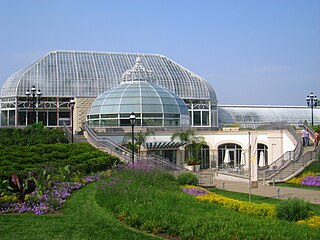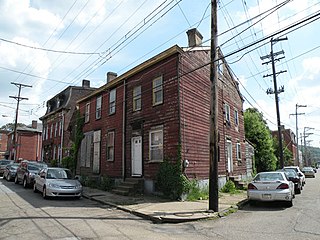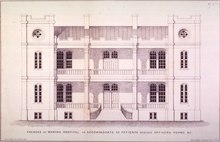
Pittsburgh is a city in the Commonwealth of Pennsylvania and the county seat of Allegheny County. It is the most populous city in both Allegheny County and Western Pennsylvania, the second-most populous city in Pennsylvania after Philadelphia, and the 68th-most populous city in the U.S. with a population of 302,971 as of the 2020 census. It is the largest city of the Greater Pittsburgh metropolitan area of Western Pennsylvania; its population of 2.457 million is the largest in both the Ohio Valley and Appalachia, the second-largest in Pennsylvania, and the 26th-largest in the U.S. It is the principal city of the greater Pittsburgh–Weirton–Steubenvillle combined statistical area that extends into Ohio and West Virginia.

Allegheny County is a county in Pennsylvania, United States. It is located in Southwestern Pennsylvania. As of the 2020 census, the population was 1,250,578, making it the state's second-most populous county, after Philadelphia County. Its county seat and most populous city is Pittsburgh, Pennsylvania's second most populous city. Allegheny County is part of the Pittsburgh, PA metropolitan statistical area and the Pittsburgh media market.

Sewickley is a borough in Allegheny County, Pennsylvania, United States, 12 miles (19 km) west northwest of Pittsburgh along the Ohio River. It is a residential suburb of the Pittsburgh metropolitan area. The population was 3,907 at the 2020 census. The Sewickley Bridge crosses the Ohio River from Sewickley to Moon Township.

The Carnegie Library of Pittsburgh is the public library system in Pittsburgh, Pennsylvania. Its main branch is located in the Oakland neighborhood of Pittsburgh, and it has 19 branch locations throughout the city. Like hundreds of other Carnegie libraries, the construction of the main library, which opened in 1895, and several neighborhood branches, was funded by industrialist Andrew Carnegie. The Pittsburgh area houses the first branches in the United States.

The University of Pittsburgh Medical Center (UPMC) is an American integrated global nonprofit health enterprise that has 92,000 employees, 40 hospitals with more than 8,000 licensed beds, 800 clinical locations including outpatient sites and doctors' offices, a 3.8 million-member health insurance division, as well as commercial and international ventures. It is closely affiliated with its academic partner, the University of Pittsburgh. It is considered a leading American health care provider, as its flagship facilities have ranked in U.S. News & World Report "Honor Roll" of the approximately 15 to 20 best hospitals in America for over 15 years. As of 2016, its flagship hospital UPMC Presbyterian was ranked 12th nationally among the best hospitals by U.S. News & World Report and ranked in 15 of 16 specialty areas when including UPMC Magee-Womens Hospital. This does not include UPMC Children's Hospital of Pittsburgh which ranked in the top 10 of pediatric centers in a separate US News ranking.

George Wilkins Guthrie served as Mayor of Pittsburgh from 1906 to 1909 and then was United States Ambassador to Japan from 1913 to 1917.

Lawrenceville is one of the largest neighborhood areas in Pittsburgh in the U.S. state of Pennsylvania. It is located northeast of downtown, and like many of the city's riverfront neighborhoods, it has an industrial past. The city officially divides Lawrenceville into three neighborhoods, Upper Lawrenceville, Central Lawrenceville, and Lower Lawrenceville, but these distinctions have little practical effect. Accordingly, Lawrenceville is almost universally treated as a single large neighborhood.
Allegheny Health Network (AHN), based in Pittsburgh, is a non-profit, 14-hospital academic medical system with facilities located in Western Pennsylvania and one hospital in Western New York. AHN was formed in 2013 when Highmark Inc., a Pennsylvania-based Blue Cross Blue Shield insurance carrier, purchased the assets of the West Penn Allegheny Health System (WPAHS) and added three more hospitals to its provider division. Allegheny Health Network was formed to act as the parent company to the WPAHS hospitals and its affiliate hospitals. Highmark Health today serves as the ultimate parent of AHN.

Hahnemann University Hospital was a tertiary care center in Center City Philadelphia. It was the teaching hospital of Drexel University College of Medicine. Established in 1885, it was for most of its history the main teaching hospital associated with its namesake medical school, Hahnemann Medical College and Hospital, founded in 1848 and named for Samuel Hahnemann, the founder of homeopathy. Hahnemann University Hospital was fully accredited by the Joint Commission on Accreditation of Healthcare Organizations.
UPMC St. Margaret is a mid-sized, acute care, teaching community hospital of the University of Pittsburgh Medical Center, located in the Lincoln–Lemington–Belmar neighborhood of Pittsburgh, Pennsylvania, adjacent to the borough of Aspinwall. Situated on 21 acres (8.5 ha), the hospital has 249 beds with more than 800 physicians and 1,500 clinical staff members. In March 2009, UPMC St. Margaret achieved Magnet Recognition status. Magnet status is the highest international recognition for nursing excellence and leadership.

The economy of Pittsburgh, Pennsylvania is diversified, focused on services, medicine, higher education, tourism, banking, corporate headquarters and high technology. Once the center of the American steel industry, and still known as "The Steel City", today the city of Pittsburgh has no steel mills within its limits, though Pittsburgh-based companies such as US Steel, Ampco Pittsburgh and Allegheny Technologies own several working mills in the Pittsburgh metropolitan area.

The Pittsburgh City-County Building is the seat of government for the City of Pittsburgh, and houses both city and Allegheny County offices. It is located in Downtown Pittsburgh at 414 Grant Street. Built from 1915 to 1917 it is the third seat of government of Pittsburgh. Today the building is occupied mostly by Pittsburgh offices with Allegheny County located in adjacent county facilities. It also contains a courtroom used for the Pittsburgh sessions of the Supreme Court of Pennsylvania.

The Allegheny Arsenal, established in 1814, was an important supply and manufacturing center for the Union Army during the American Civil War, and the site of the single largest civilian disaster during the war. It was located in the community of Lawrenceville, Pennsylvania, which was annexed by the city of Pittsburgh in 1868.
The School of Public Health is one of 17 schools at the University of Pittsburgh. The school, founded in 1948, was first led by Thomas Parran, surgeon general of the U.S. Public Health Service. It is ranked as the 13th best public health school in the United States by U.S. News & World Report. In addition, it is ranked third among public health schools for funding received from the National Institutes of Health. It was the first of only two fully accredited schools of public health in Pennsylvania. The school offers a Bachelor's of Science in Public Health (BSPH), Masters of Public Health (MPH), Master of Science (MS), Master of Health Administration, and doctoral degrees in areas such as behavioral and community health sciences, biostatistics, environmental and occupational health, epidemiology, health policy and management, human genetics, and infectious disease and microbiology.

The Washington Crossing Bridge, commonly known as the Fortieth Street Bridge, is an arch bridge that carries vehicular traffic across the Allegheny River between the Pittsburgh neighborhood of Lawrenceville and the suburb of Millvale. The bridge is decorated with the seals representing the original 13 colonies of the US and that of Allegheny county.

184 38th Street, also known as McBride Log House, was a historic log house in the Lawrenceville neighborhood of Pittsburgh, Pennsylvania. Before its demolition, it was thought to be the oldest log house in any major American city to be used as a residence.

The Lawrenceville Historic District is a U.S. historic district in Pittsburgh, Pennsylvania, which encompasses the majority of the Lawrenceville neighborhood. The historic district includes 3,217 contributing resources, many of which are rowhouses, commercial buildings, and former industrial properties built between the 1830s and early 20th century. The district was listed on the National Register of Historic Places in 2019.

The Division of Industrial Hygiene was a division of the U.S. Public Health Service (PHS) with responsibility for occupational safety and health programs. It existed from 1914 until 1971, when it became the National Institute for Occupational Safety and Health (NIOSH). It had several names during its existence, most notably the Office of Industrial Hygiene and Sanitation in its earlier years and the Division of Occupational Health during its later years.




















